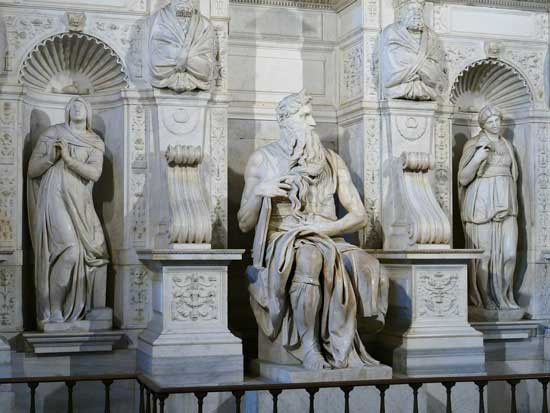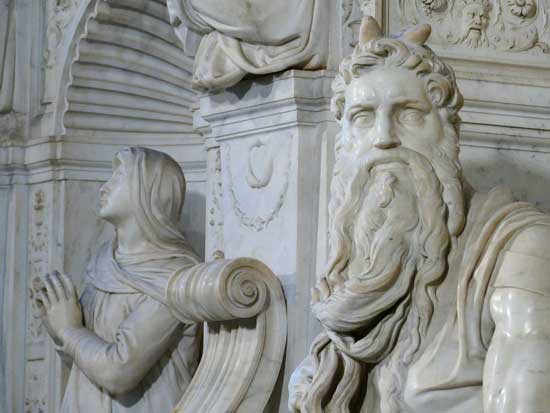At the beginning of the sixteenth century Michelangelo had already established himself, between Rome and Florence, as a young artist capable of exceptional feats. He had in fact, at the age of 23, he had already created the famous sculptures of the Pietà and the David. After his first stay in Rome and the series of Florentine works of art his reputation was at its peak, as confirmed by Vasari, who in his Vite writes: “the fame of Michele Agnolo for the Pietà, for the giant of Florence and for the paintings so well known, that Pope Julius II deliberated his sepulchre.”

The assignment to work at the tomb of Julius II – which he will never see accomplished since he died in 1513 – was assigned to Michelangelo in 1505, but due to a series of complex events, the date of completion is indicated as 1545. Meanwhile Michelangelo will paint the ceiling of the Sistine Chapel (1508-1512), commissioned by Julius II (who died in 1513), he will realize the wonderful Medici tombs and attend to the works of the new sacristy of San Lorenzo in Florence (1520-1534), in addition to painting the Last Judgment of the Sistine Chapel (1535-1541).
The final design of the tomb of Julius II, however, was considerably reduced compared to the original one: from the idea of a huge mausoleum that was supposed to contain more than forty statues, after six different projects, the choice fell on a monumental wall with seven statues of which only three belonged to the hand of the artist from Arezzo.
This assignment created in him great anxiety and psychological pressure, sufficient to call it a “tragedy”: the slanders, the envies and accusations from Rome during all the years of work cost him dear, both in moral and psychophysical terms.
Although downsized, the papal sepulchre maintains a remarkable compositional linearity and, although at the time it had been heavily criticized as not worthy of a Pope, it confirms Michelangelo’s excellence. Today the sepulchre is considered as one of the keys to understand not only the work of the great artist from Arezzo, but the whole 16th century: an artistic period strongly linked to the political and religious vicissitudes of the transition from the Reform to the Counter-reform of the Council of Trent.
One of the elements that contributes considerably to the consistency of Michelangelo’s entire work is definitely the statue of Moses, so much so that it has become synonymous with the burial that it was only supposed to decorate. The work on the statue began in 1514, at the dawn of the second project for the papal tomb, which had been signed the previous year; the statue was then placed in its final version at the centre of the lower order of the monument itself, while it was originally supposed to be situated in an elevated position.
Much has been said and written about this great work. Stories, testimonies, analysis and legends overlap and help to make it one of the richest in meaning of all Michelangelo’s art. To talk about it means not only making a formal description of it, but also retracing centuries of critical contributions that overlap, reinforce and deny each other. For a start, it can be said that the Michelangelo’s Moses is certainly not the biblical Moses who, according to the Old Testament, had an irritable temper and threw to the ground the tablets of law just received from God, after seeing the Jews, who, tired of waiting, had begun to worship a golden calf. According to Freud, who was struck by the statue, the marble Moses represents a man torn between impetuosity and inner firmness, certainly not in anger. Indeed, anger is overcome by firmness, producing an attitude of pain mixed with contempt. The interpretations can be many however and Freud’s interpretation appears to be a victim of professional bias of sort.
In any case, the strength of its expression is such that, according to Vasari, many Roman Jews crowded the basilica to admire it although it was in a Catholic place of worship. The beard, dense and wonderfully carved in marble, the vigorous and stern gaze, the big hands that strongly recall those of the David in Florence and, above all, the twisting of the body: Moses appears caught in the instant immediately following some impulse that distracted him from a deep reflection. He seems about to jump up, creating a sense of reverence and awe, if not in towards the biblical character, towards the work of art itself.

The horns, which appear inexplicable and which intrigue so much those who approach the statue for the first time, are actually part of the traditional iconographic set accompanying the representation of Moses and which have their origin in the translation of St. Jerome’s text of Exodus. Originally, in fact, the biblical text described Moses bathed in light rays after receiving the boards: the translation that followed interpreted the word “rays” (karan) with the word “horns” (keren). The fact that this feature was customary at the time of Michelangelo, is confirmed by a reading of the Condivi “he has, according to what needs to be described, two horns on his head, little distant from the top of the forehead.”
It is said that Michelangelo, after finishing the work, in a moment of contemplation and momentary estrangement – perhaps in the throes of what Kant would have two centuries later defined sublime – shouted at the statue: “Why don’t you speak?” while striking the its knee with a hammer.
Although the veracity of this anecdote is very doubtful – it smells too much on a solemn exaltation of genius of romantic kind to be plausible – the realism of the work, combined with a sense of solemn reverence that we have already mentioned, implies the reasons for the legendary gesture.


